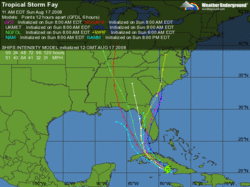The damage in New Orleans was hurricane related, but it wasn’t the damage you expect in a hurricane. On the Mississippi coast structures were blown apart. In New Orleans most buildings were intact until they were flooded.
 As I type this, Gustav is somewhere near the Cayman Islands, picking up strength and heading toward the Gulf of Mexico. The Gulf is warm. Gustav will strengthen some more.
As I type this, Gustav is somewhere near the Cayman Islands, picking up strength and heading toward the Gulf of Mexico. The Gulf is warm. Gustav will strengthen some more.
For the past few days the official Hurricane Center Track has pushed Gustav toward the Louisiana coast sometime late Monday/early Tuesday. The latest center of the track would bring landfall west of the Mississippi over a swampy, sparsely populated area near Vermillion Bay. That would put New Orleans on the stronger side of the storm, but possibly far enough away to escape the worst. Katrina struck on the opposite side of New Orleans–actually on the Mississippi coast. For Katrina, New Orleans was on the weak side!
Monday’s a long way off. The track will certainly shift somewhat by then.
There is a misconception most people have about Katrina. I’m writing tonight to put that part of the Katrina saga in perspective. The damage in New Orleans was hurricane related, but it wasn’t the damage you expect in a hurricane. On the Mississippi coast structures were blown apart. In New Orleans most buildings were intact until they were flooded.
I’m not saying there wasn’t damage before the water–there most certainly was. But New Orleans wasn’t flattened by a hurricane. It didn’t receive strong and sustained hurricane force winds. It was not the ‘worst case scenario’ storm New Orleans had feared.
I wrote this as Katrina began to pull away Monday evening.
Katrina Comes Ashore 08/29/05 9:21 PM
New Orleans wasn’t totally laid to waste. There has been plenty of damage, and once we get out of the ‘fog of war’ we’ll find plenty more. The coasts of Alabama and Mississippi really took the brunt of Hurricane Katrina. That was more than expected.
After the fact, I still agree with the decision to empty out New Orleans. Yes, some people will crawl out of the woodwork to say they rode it out and it wasn’t that bad. That’s not the point.
At this point the New Orleans hurricane damage from Katrina wasn’t that bad. The damage we all saw didn’t start until later Monday night long after the storm was over. It was as if the Katrina unfolded in slow motion.
Bad News For New Orleans, Out of Left Field 08/30/05 3:02 AM
Rick Sanchez was on the air, speaking by phone with someone from Tulane Hospital in New Orleans. The hospital’s spokesperson was talking about water – rising water.
The hospital had seen no real flooding while Hurricane Katrina passed by, but tonight, water had begun rushing in and it was rising at an alarming rate.
I could hear the fear in her voice as she described the water level rising an inch every five minutes. That’s a foot an hour. Already there was six feet of water outside the hospital. Soon, water would reach the level of their emergency generators on the second floor.
Sanchez was taken aback. I’m not sure he originally understood what she was saying. It was so unexpected – so out of context.
She said a levee keeping Lake Ponchartrain out of New Orleans had been breached. The cut in the levee was two blocks long and water was rushing in unimpeded. Even if there were pumps working, and she wasn’t sure there were, they wouldn’t be able to keep up with this deluge.
On CNN, Rick Sanchez kept asking questions, but it was obvious this woman wanted to get off the phone. Speaking to him wasn’t going to help her.
I heard terror in her voice.
The hospital had to get its patients out. Its patients were by and large critical. The only way to move them would be by helicopter and FEMA would be needed for that.
The other all news stations are in their usual reruns. I have no way of knowing if this is true. If it is, this is New Orleans’ worst fears are realized. Lake Ponchartrain could inundate the city.
Here’s my point. If Gustav gets strong (likely) and hits just west of New Orleans (possible) there will be a different type of damage in the Crescent City. New Orleans could just get blown over. Nothing FEMA or the Corps of Engineers has done would prevent this kind of destruction.
I’m not sure which scenario is worse–what happened in ’05 or what’s possible in a few days. They are not, unfortunately, mutually exclusive scenarios.






